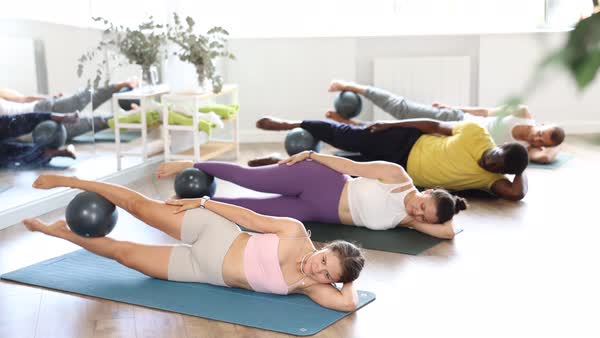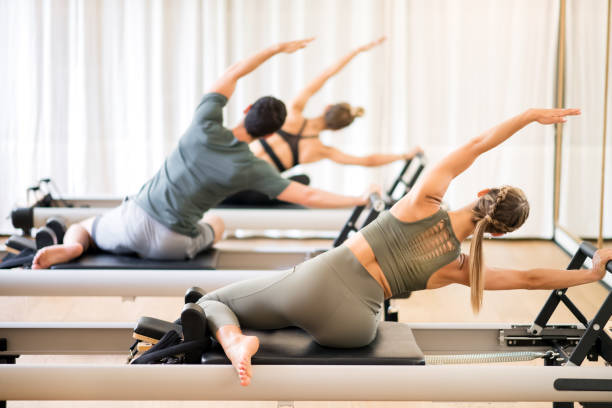Yoga and Pilates
Yoga and Pilates are two well known types of activity that have acquired huge notoriety throughout the course of recent many years. Both proposition an all encompassing way to deal with actual wellness and mental prosperity, however they contrast in their starting points, reasoning, and explicit methods. While yoga began in old India as a profound and actual practice pointed toward joining the brain, body, and soul, Pilates was created in the twentieth 100 years by Joseph Pilates as a technique for working on actual strength, adaptability, and stance. In spite of their disparities, both yoga and Pilates underscore mind-body association, breath control, and center strength, creating them correlative practices that can be coordinated into a fair wellness schedule.
The Beginnings of Yoga
Yoga is an old discipline with establishes in Indian way of thinking that goes back more than 5,000 years. "Yoga" comes from the Sanskrit root yuj, and that signifies "to join together" or "to join." In its earliest structure, yoga was principally a profound practice intended to develop mindfulness, self-restraint, and edification. It included reflection, breathwork (pranayama), and actual stances (asanas) to orchestrate the body and brain.
Throughout the long term, yoga advanced into different schools and styles, including Hatha yoga, which centers around actual stances and breath control; Bhakti yoga, which underlines commitment and love; and Karma yoga, which is focused on magnanimous activity. Today, many types of yoga are drilled around the world, with Hatha yoga and its subordinates being the most well-known in the West.
The Beginnings of Pilates
Pilates, conversely, is a somewhat present day actual wellness framework made by Joseph Pilates in the mid twentieth hundred years. Brought into the world in Germany, Pilates was a debilitated youngster who experienced asthma, rickets, and other medical problems. Not entirely settled to beat his actual limits, he fostered a progression of activities that zeroed in on fortifying the body's center muscles — those encompassing the spine, pelvis, and mid-region.
Pilates at first referred to his framework as "Contrology," underscoring the significance of control, accuracy, and taking in development. Subsequent to moving to the US during the 1920s, he opened a studio in New York, where his activities acquired notoriety among artists and competitors. Pilates' technique depends on the possibility that a solid center is fundamental for further developing stance, adaptability, and generally speaking body strength. After some time, the training developed into a well known wellness system, with present day varieties including mat Pilates and hardware based Pilates utilizing machines like the reformer.
Key Standards of Yoga
Yoga has a few center rules that guide its training. These standards are established in both physical and philosophical parts of the training:
Asana (Stances): The actual stances are the most unmistakable part of yoga. Asanas help to fortify, stretch, and adjust the body. They range from basic stances like the descending canine to additional complicated postures like the headstand or lotus position. The objective of asanas is to build adaptability, solidness, and generally speaking actual wellbeing.
Pranayama (Breathing): Breath control is key to yoga. Pranayama includes different procedures for directing the breath, including slow, profound breathing and substitute nostril relaxing. These practices are intended to increment oxygen admission, quiet the sensory system, and further develop center during actual practice.
Contemplation and Care: Yoga isn't simply an actual exercise; it is likewise a psychological and profound practice. Contemplation, care, and self-reflection are essential pieces of yoga, assisting professionals with interfacing with their internal identities and develop a feeling of harmony and happiness.
Vinyasa (Stream): In many types of yoga, for example, Vinyasa yoga, there is an accentuation on smooth motion. This is designated "stream," where one development is connected to the following in a nonstop, agreeable succession. Vinyasa practice energizes coordination among breath and development, making a reflective encounter that advances actual perseverance and mental clearness.
Key Standards of Pilates
Pilates additionally has own arrangement of core values put it aside from different types of activity:
Center Strength: Pilates is broadly centered around fortifying the muscles of the center. The center incorporates the abs as well as the muscles of the back, hips, and pelvis. A solid center further develops act, forestall injury, and upgrade generally speaking development.
Control and Accuracy: Every development in Pilates is performed with control, accuracy, and focus. Dissimilar to additional unique activities that include fast or focused energy developments, Pilates stresses slow, intentional movements to guarantee that each muscle is locked in appropriately.
Breath: Very much like yoga, breathing assumes a significant part in Pilates. The breath works with development, give energy, and upgrade center. In Pilates, professionals are urged to inhale profoundly and in a joint effort with each activity, frequently breathing in through the nose and breathing out through the mouth.
Stream and Adaptability: Pilates developments are intended to stream flawlessly starting with one then onto the next. The thought is to keep a feeling of smoothness and equilibrium in all activities. While strength is underscored, adaptability is additionally a significant part, assisting with forestalling injury and upgrade scope of movement.
Looking at Yoga and Pilates
While both yoga and Pilates underline breath control, adaptability, and center strength, they vary in more ways than one. Understanding these distinctions can assist you with concluding which practice is best for your own wellness objectives.
1. Focal point of the Training
Yoga: The essential focal point of yoga is on the brain body association. While actual wellness is a significant part of yoga, the training additionally integrates reflection, mindfulness, and otherworldly development. In yoga, the stances are utilized to set up the body for contemplation and to develop internal harmony. It is all encompassing in nature, tending to the psychological, physical, and close to home parts of the specialist.
Pilates: Pilates, then again, is more centered around the actual body. The framework is explicitly intended to further develop strength, adaptability, and stance. Pilates is especially powerful in focusing on the muscles of the center, however it additionally works different region of the body. Pilates is less worried about the psyche body association and otherworldly development, and more centered around restoration, body arrangement, and strong equilibrium.
2. Power and Approach
Yoga: Yoga offers a wide range of force contingent upon the style. For instance, Hatha yoga will in general be delicate and helpful, while Ashtanga and Vinyasa yoga can be all the more truly requesting and speedy. Numerous yoga styles consolidate unwinding and care, making yoga a balanced practice for both strength and mental clearness.
Pilates: Pilates is normally a more extraordinary exercise zeroed in on developing fortitude, particularly in the center. The activities are controlled, exact, and frequently dreary, which assists with building muscle perseverance and further develop adaptability. While it is less centered around unwinding than yoga, Pilates is exceptionally successful for conditioning muscles and further developing stance.
3. Adaptability and Versatility
Yoga: One of the trademark advantages of yoga is expanded adaptability. Numerous yoga presents are intended to extend and protract muscles, which can further develop portability and generally speaking body adaptability. Yoga is frequently a go-to rehearse for people hoping to build their scope of movement and adaptability.
Pilates: While Pilates further develops adaptability, its primary spotlight is on strength. Pilates practices are intended to further develop muscle tone, especially in the center, and upgrade by and large body arrangement. Notwithstanding, Pilates can likewise upgrade adaptability through controlled extending and protracting developments, particularly when joined with different types of activity.
4. Mental Concentration
Yoga: Yoga puts major areas of strength for an on mental mindfulness, unwinding, and care. Numerous yoga classes incorporate a directed contemplation or unwinding toward the finish of the meeting. This makes yoga an extraordinary practice for people looking for mental lucidity, stress help, and profound equilibrium.
Pilates: While Pilates requires mental concentration and fixation, it is fundamentally an actual exercise. The accentuation is on performing practices with accuracy and control, frequently utilizing gear, for example, the reformer to direct development. Pilates does exclude reflection or care methods in the manner yoga does.
Advantages of Yoga and Pilates
Both yoga and Pilates offer a large number of physical and mental advantages that can upgrade your general wellbeing and prosperity. A portion of the critical advantages of each training include:
Advantages of Yoga:
Expanded Adaptability: Yoga is profoundly compelling for further developing adaptability in the muscles and joints.
Stress Alleviation: The emphasis on breathwork and care decreases pressure and tension.
Further developed Stance: Yoga assists with further developing stance by fortifying the muscles that help the spine.
Better Equilibrium and Coordination: Numerous yoga presents challenge equilibrium and strength, working on by and large coordination.
Mental Clearness and Concentration: Yoga empowers care, which can prompt more prominent mental lucidity and profound prosperity.
Advantages of Pilates:
Center Strength: Pilates is eminent for its emphasis on reinforcing the center, which is fundamental for generally body strength and stance.
Muscle Tone and Perseverance: Pilates practices target both huge and little muscle gatherings, assisting with building muscle tone and perseverance.
Further developed Stance: Pilates advances legitimate body arrangement and can ease muscle uneven characters that add to unfortunate stance.
Recovery: Pilates is many times utilized in non-intrusive treatment to restore wounds, particularly those connected with the spine and center muscles.
Expanded Adaptability: Pilates additionally improves adaptability, especially in the muscles encompassing the center and lower back.
Incorporating Yoga and Pilates into Your Daily practice
While yoga and Pilates have particular contrasts, they complete one another quite well. A huge number decide to integrate both into their wellness schedules to partake in the advantages of each. For instance, yoga can assist with further developing adaptability and decrease pressure, while Pilates can upgrade.





0 Comments